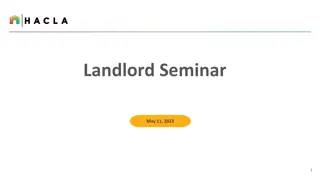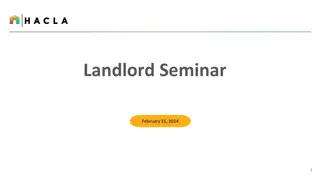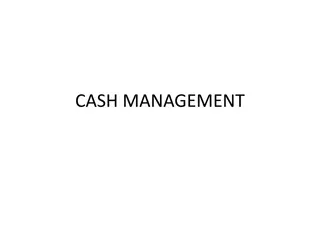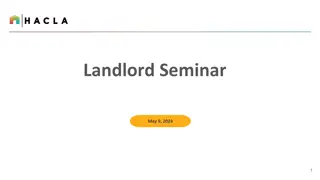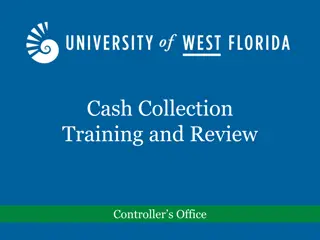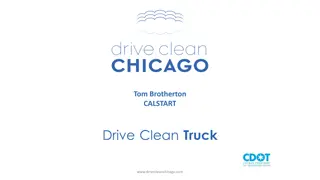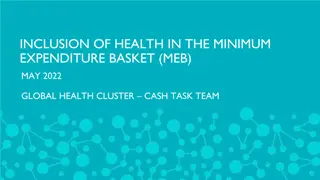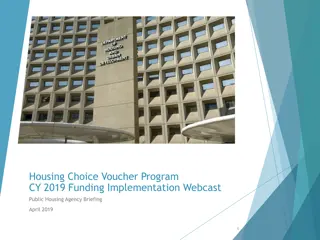Exploring Cash and Voucher Assistance for Nutrition Outcomes in Emergencies
Launching a comprehensive Evidence and Guidance Note on the use of Cash and Voucher Assistance (CVA) for improving nutrition outcomes in emergency settings. The webinar agenda covers key terminology, evidence-based insights, recommendations for nutrition practitioners, and insights on the impact of CVA on maternal and child nutrition, emphasizing the importance of targeted assistance delivery mechanisms.
Download Presentation

Please find below an Image/Link to download the presentation.
The content on the website is provided AS IS for your information and personal use only. It may not be sold, licensed, or shared on other websites without obtaining consent from the author. Download presentation by click this link. If you encounter any issues during the download, it is possible that the publisher has removed the file from their server.
E N D
Presentation Transcript
Preliminary Launch of the Evidence and Guidance Note on the Use of CVA for Nutrition Outcomes in Emergencies 28 July 2020 Andre D rr, andurr@unicef.org
Agenda of the webinar Introduction, terminology Part I: Evidence Note, followed by Q&A Part II: Guidance Note Recommendations to nutrition cluster/sector coordinators and nutrition practitioners Q&A Next steps
Introduction Poll: who are you? Recognition that CVA can support nutrition outcomes CashCap support to the GNC since August 2019 Reference Group, consisting more than 15 organizations Results: Evidence and Guidance note Evidence and practice review More than 50 key informant interviews Two case studies: Nigeria and Somalia Target audience
Introduction: CVA terminology CVA = provision of cash or vouchers to targeted recipients (individuals, households or communities) to access goods and services What is not CVA? Payment of incentives for volunteers or CHW, payments to institutions (schools, health centres, etc.) BASIC NEEDS DESIGN What the interventions aim to achieve (objectives), and/or how they are designed SECTOR SPECIFIC MULTIPURPOSE CASH TRANSFER CONDITIONAL QUALIFYING Activities or obligations that must be fulfilled in order to receive assistance UNCONDITIONAL E.g. Participation in SBC sessions, attendance to health services
Introduction: CVA terminology UTILIZATION Limitations, if any, on use of assistance received. What a transfer can be spent onafterthe recipient receives it UNRESTRICTED RESTRICTED IN-KIND MODALITY The form of assistance provided to recipients CASH TRANSFER SERVICE DELIVERY Commodity voucher VOUCHER Value voucher DELIVERY MECHANISM The means of delivering a transfer CASH IN HAND E- PAPER VOUCHER E-CASH VOUCHER
Part 1: Evidence Note on the Use of Cash and Voucher Assistance for Nutrition Outcomes
CVA the conceptual framework CVA can impact underlying determinants in three main ways: i. allows HHs and individuals to purchase goods and access services that can have a positive impact on maternal and child nutrition ii. Conditional CVA can be an incentive to participate in nutrition SBC activities and attend to free priority health services. iii. Increased household income can reduce household tensions, economic pressures, enhance decision-making power of women, improve health and well-being of caregiver, etc.
CVA impact on maternal and child nutrition Level of impact Mostly positive Mixed None Impact on nutrition status of children Child nutrition status Impact on immediate determinants Dietary diversity of children Health status of children Impact on underlying determinants Household food expenditure Household food consumption and dietary diversity Uptake in preventative services Water, sanitation and hygiene Feeding behaviours and practices Psychosocial care for children Intra-household decision making Intimate partner violence Caregivers mental health ** ** * *** *** health ** * * * ** ** * Strength of evidence: * none or limited, ** growing, *** moderate, **** strong
Demand and supply-side barriers to adequate nutrition Supply side barriers Demand side barriers Underlying determinant: adequate food Examples - Insufficient availability and/or quality of foods in local markets Examples: - Insufficient knowledge and skills on nutritious diet preparation - Markets not accessible due to distance, safety concerns, etc. Economic barriers: - Nutritious diet, cooking utensils and fuel not affordable - Transportation to markets not affordable healthy/nutritious Underlying determinant: adequate feeding and care Example: - IYCF services and support for adequate care (e.g. health services, IYCF counselling services, women support groups) are not available or not functional Example: - Inadequate knowledge and skills on caring practice and how to prepare nutritious complementary food Economic barriers: - Preparation of adequate affordable - Lack of caregivers time for optimal feeding and care due to economic pressure (e.g. work) complementary food not
Demand and supply-side barriers to adequate nutrition Supply side barriers Demand side barriers Underlying determinants: healthy environment Examples: - Health available - Health service of insufficient quality - Adequate drugs, therapeutic foods) and equipment for maternal and child health services are not available Examples: - Inadequate health seeking behaviour due to lack of knowledge of malnutrition, traditional beliefs, etc. - Lack of knowledge and skills on WASH practices Economic barriers: - Accessing and using health services is not affordable due to direct costs and indirect costs - Opportunity costs of seeking health and nutrition services are considered too high - Hygiene items not affordable - Safe water and water treatment not affordable services not sufficiently supplies (e.g. CVA can help to address demand side economic barriers to adequate nutrition, but is less effective on the supply side CVA alone unlikely to be successful strategy to improve nut status of children. It should be combined with other nutrition sensitive or specific interventions
Most common approaches to integrate CVA in nut response Based on a review of studies and opreational examples, five main appraoches to integrate CVA in nutrition response were identified: 1) Using CVA modalities for household assistance and/or individual feeding assistance 2) Pairing household CVA and context-specific SBC 3) Providing conditional cash transfers to incentivize attendance to priority health services 4) Provide CVA to facilitate access to treatment services 5) Provide household CVA to caregivers of SAM children Can be combined with each other and be a component of a broader nutrition response!
1) Use CVA for household and/or individual feeding assistance CVA can be considered for both components, with limitations for individual feeding: CVA can be considered as an alternative to in-kind provision of fortified blended foods and lipid-based nutrient supplements for the prevention of malnutrition if healthy and fortified foods with the required micro and macronutrients are locally available, accessible and can be prepared with sufficient nutrient density CVA should not be considered an alternative to the provision Micronutrient Powers CVA should not be considered an alternative to the provision of Specialized Nutritious Foods (SNF) in treatment of malnutrition Different combinations possible but limited evidence what works best Household cash transfer plus SNF promising approach Good operational experiences with fresh food vouchers for ind. feeding Cash transfers might be more adequate for HH component, SNF (and vouchers) might be more adequate for individual feeding
2) Pair household CVA and Social and Behavioural Change CVA and SBC seems to positively reinforce each other: SBC component seems to promote nutrition-sensitive and child/women-centred spending decisions CVA can allow recipients to put knowledge and skills from SBC on nutritious diets, complementary feeding, etc. into practice specific behaviors to be targeted through SBC vary according to the context and should be informed by adequate research and assessments: optimal breastfeeding, complementary feeding, healthy diets, sanitation and hygiene, health seeking, etc. SBC activities can be (soft) conditional on CVA relatively strong evidence from studies and operational experience for effectiveness of this approach
2) Pair household CVA and Social and Behavioural Change Cash transfers that aim to contribute to nutrition outcomes need to be accompanied with context-specific SBC activities. Value vouchers aiming to contribute to nutrition outcomes should be accompanied with context-specific SBC activities Examples
3) Provide CCTs as an incentive to attend to priority health services Importance of priority preventative health services for maternal and child nutrition Cash transfers conditional on the attendance to priority health services can fulfil several objectives: to cover indirect costs and reduce opportunity costs Increase attendance by providing an incentive provide household income to contribute to nutrition outcomes Evidence base strong in development settings and growing in humanitarian settings (most examples not from nut programmes) Different ways to design conditionality (registration vs visits) and transfer amount (based on indirect costs or household basic needs) Examples: AAH in Nigeria, WVI in Bangladesh
4) Provide CVA to facilitate access to treatment services CVA can cover indirect costs of accessing treatment of malnutrition Indirect cost: transportation costs, cost related to accommodation and food if caregiver needs to stay with the child (in-patient care) Cash or vouchers for transportation: Common but poorly documented Examples: AAH in the DRC, UNICEF in Pakistan Cash or vouchers for food and accommodation for caregiver during in- patient care: no examples found Need to document experiences and learning: Is it better to advance the money at the point of referral or should the cash be provided at the health centre? How should the amount for transportation be calculated? What is the preferred modality (cash or voucher) to cover indirect costs to access treatment?
5) Provide household CVA to caregivers of SAM children One study in the DRC: children in households that received cash transfers gained weight faster, were more likely to recover from SAM and less likely to default or fail to respond to treatment ICRC, UNICEF and AAH have used this approach in different contexts Anecdotal evidence for caregivers making or keeping a child malnourished to access cash assistance; risk is not well understood Possible mitigation measures: not continuously enroll children, provide assistance irrespective of recovery of child, limit transfer amount Approach to be further explored, but risk of perverse incentive and possible mitigation measures to be explored in community consultations and risk to be monitored during implementation
End of Part I: Evidence Note Questions on Evidence Note?
Part 2: Guidance Note on the Use of Cash and Voucher Assistance in Nutrition Response
Steps to consider and use CVA in nutrition response Cross-cutting considerations: - Preparedness - Coordination - Information Mgmt - Risk analysis and mitigation Step 1: Determine whether CVA can contribute to nutrition outcomes Step 2: Determine the feasibility of CVA as part of a nutrition response Step 3: Determine and select response options and response modalities Step 4: Design the CVA component Step 6: Monitoring of the CVA component Step 5: Implement the CVA component
Step 1: Determine whether CVA can contribute to nut outcomes Entry point: Demand-side economic barriers to adequate nutrition To what extent is the lack of purchasing power impacting the ability of households to access and prepare nutritious foods, access health services, access safe water, improve hygiene conditions Comprehensive understanding of all demand and supply side barriers required to assess whether CVA has a role to play Opportunities of nutrition assessment tools to contribute to an understanding of economic barriers, for example: KAP/Barrier Analysis: economic barriers to desirable WASH (e.g. water treatment), health and care practices SQUEAC: economic barriers to accessing health and nutrition services IYCF assessments: economic barriers to adequate feeding and care To be complemented by assessments from other sectors (FSL, health, WASH): Cost of the Diet, Household Economy Approach
Step 2: Determine the feasibility of CVA Market capacity and functionality: can a nutritious diet be achieved using locally available foods? Are goods required for adequate WASH available? Health and transportation services: Are relevant health and nutrition services for the prevention and treatment of malnutrition available and of acceptable quality? Are transportation services available to access health and nutrition services? Delivery mechanisms: Is there a safe and reliable way to deliver cash or vouchers? Community considerations: data protection, preference on ways to be assisted, protection risks and safety considerations, access to money, access to markets, household decision making, possible tensions within households or communities Additional: Acceptance of authorities, organizational capacity, risks, costs Most information probably available (secondary info), consult with others!
Step 3: Determine and select response options and modalities CVA does not change the way nutrition practitioners define objectives and select nutrition response options in order to address identified nutritional needs, e.g. treatment through CMAM, IYCF-E, supplementary feeding, micronutrient supplementation, etc. CVA ads modalities on how to achieve identified objectives Economic barriers to the underlying determinants feasible CVA modalities and approaches should be considered as part of response options analysis
Step 4: Design the CVA component Targeting Eligibility criteria are largely determined by the programme objectives and type of response rather than the assistance modality Not really different to targeting of in-kind assistance Socio-economic criteria can be considered on top of other criteria Conditionality Options: hard vs soft conditionality Consider when it is expected to improve participation in SBC interventions and the uptake of priority preventive health service Expected benefits vs additional costs and resources Timing, duration and frequency Longer duration, higher cumulative transfer amount better impact Safety net response: throughout first 1000 days; no less than 3 months
Step 4: Design the CVA component Expenditure basket and transfer amount transfer amount for CVA should reflect what recipients are expected to be able to purchase on local markets depends on objective of CVA component Common expenditure baskets: MFB ( access nutritious diet at household or individual level), MEB ( access nutritious diet and other nutrition relevant goods and services at household level) In reality: MFB composition reflects energy-based diet. It often lacks diversity and falls short of addressing micronutrient requirements. Transfer amount = expenditure basket HHs own contribution
Step 4: Design the CVA component MEB Nigeria Rice Maize Beans Palm Oil Groundnuts Sugar Veg Oil Salt Onion Non leafy vegetables Leafy vegetables Fruits Meats Chicken eggs Vinegar (firewoods, briquettes and charcoal) Water + water vendor fees kgs kgs kgs liter kgs kgs liter kgs kgs 27 45 Nutrition practitioners should work with existing contextualized MEB/MFB and transfer amounts, adjust these as required in accordance to programme objectives, and if necessary advocate for adjustments to reflect a stronger nutrition lens. 13.5 1.8 2.7 1.8 3.6 0.9 1.44 Basic food items kgs 2 kgs kgs kgs pcs liters 2 1 Condiments and supplements 0.5 12 1 Cooking fuel bag 1 Jerryca ns (20L) bar (60g) bar (200g) 158 Bathing soap 13 WASH Items Laundry Soap 3 Sanitary pads (pack of 8 pcs) Average expense (out of pocket money + external costs) for 1 person pack 4 Health expenses pcs 7
Step 5: Implementation of the CVA component Essential components of the implementation stage defining roles and responsibilities in alignment with existing Standard Operating Procedures (SOPs), putting in place internal and external coordination mechanisms, setting up a beneficiary communication and accountability system, select and contract service providers/vendors for the disbursement of cash transfers and the redemption of vouchers, identify and register beneficiaries, and carry out and accompany the distribution of cash or vouchers.
Step 6: Monitoring of the CVA component Monitor nutrition outcomes largely depends on the programme objective and is as such not tied to the assistance modality When CVA is provided to give access to healthy and diverse diet, move beyond HH level indicators and include indicators at individual level: Minimum Dietary Diversity for Women (MDD-W), Minimum Acceptable Diet (MAD), Minimum Dietary Diversity (MDD) and Minimum Meal Frequency Expenditure information important to collect (money spend on good and services relevant to nutrition outcomes?). Expenditure information can inform pathways and unaddressed vulnerabilities. Market price monitoring and risk monitoring
Crosscutting considerations Preparedness Steps 1-6 at based on identified scenarios Organisational readiness, partnerships in place Coordination CVA coordination architecture Need to closely coordinate with CWG and other relevant sectors CVA components as part of nutrition response should be coordinated by the nutrition cluster/sector: assessment, CVA feasibility, response analysis, design, implementation, monitoring and learning Information Management CVA component of nutrition response should be reported under the nutrition cluster
Crosscutting considerations Risk analysis and mitigation CVA modalities are not riskier that other modalities and most risks are not specific to CVA Pay particular attention to protection risks
Recommendations to nutrition cluster/sector coordinators Work with other sectors in the assessment of demand and supply side barriers to adequate nutrition, including economic barriers Work with CWG on CVA feasibility for nutrition response Support partners to systematically consider cash and voucher modalities and approaches in nutrition response analysis Promote adequate opportunities to use CVA modalities and approaches as a component of nutrition response Work with the FSC on using CVA modalities for household assistance and/or individual feeding assistance; with HC on using CVA to improve access to free priority health services and treatment of malnutrition Support the establishment and revision of MFBs/MEBs and advocate for a nutrition lens Promote the documentation and dissemination of lessons learned on the use of CVA for nutrition outcomes. Promote CVA capacity and confidence building of local/national partners
Recommendations to nutrition practitioners Contribute to a common understanding of barriers to adequate nutrition, including economic barriers Contribute to a common understanding of feasibility and adequacy of using CVA modalities and approaches for nutrition outcomes. Routinely consider cash and voucher modalities and approaches in the nutrition response analysis process. Select CVA approaches and design the CVA component of a nutrition response based on current good practice Invest in monitoring and evidence generation of nutrition programmes with a CVA component. Proactively disseminate lessons learned on CVA for nutrition outcomes Build CVA capacities and confidence of nutrition practitioners.
End of Part 2: Guidance Note Questions on Guidance Note? Poll at the end


